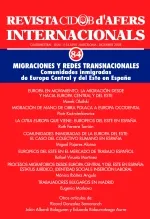Migrations and transnational networks: Immigrant communities from Central and Eastern Europe in Spain.

Revista CIDOB d'afers internacionals, núm. 84
In 2004 and 2007, the European Union's enlargements toward Eastern Europe sparked an interesting debate on the challenges that the Union's newly-incorporated population could represent for the job markets of the other Member States. Just like with Spain and Portugal's entry into Europe in 1986, EU countries were afraid that the resulting free circulation would bring about an “avalanche” of workers from “new” Europe in search of better employment opportunities. The existence of East-to-West migration flows would take on (after years when the political and ideological dimension had had a substantial importance) a new economic dimension up until the present that is by no means representative. But furthermore, the attention paid to the migration phenomenon in the countries of the East highlighted the existence of a specific migration model in these countries, which are transforming from countries of emigration to ones of immigration, and in which temporary, circular and return immigration have a greater importance than in other European scenarios. The latest issue of CIDOB magazine Afers Internacionals is made up of different perspectives on this phenomenon, as well as on the participation of immigrants from Central and Eastern Europe in Spain's society and job market.
ISSN: 1133-6595
>> Complete texts of the articles in Spanish and French version